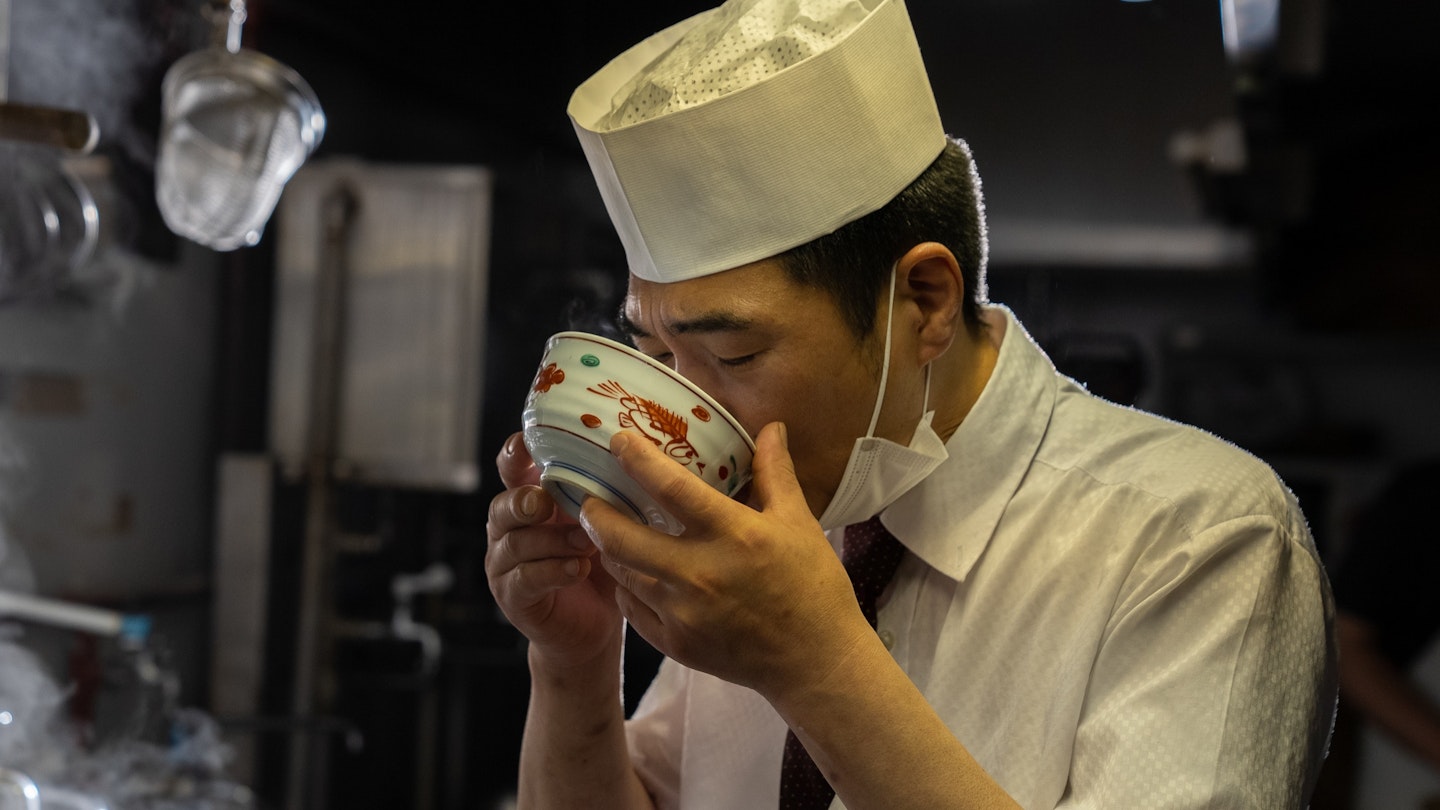Japan is the kind of destination that catches your attention at every turn.
With its dramatic landscapes, one-of-a-kind cuisine, steaming onsen, fragrant ramen, and bustling cities, Japan is a feast for the senses.
Prepare for a sensory awakening as we (re)discover an array of iconic destinations and attractions in Tokyo and Osaka – some brand new, some made classic by time – and explore them using all five of our senses.
Touch: Tokyo’s Janoyu Onsen Takaraso
Located deep in the mountains of Hinohara Village in Tokyo’s far-west, Janoyu Onsen Takaraso is the only onsen (hot springs) in Tokyo that is part of the Japan Association of Secluded Hot Spring Inns.
Immerse yourself in the healing waters of Janoyu, which is attached to a 300-year-old thatch-roofed house in the distinctive shape of a warrior’s helmet. Janoyu literally means “snake onsen,” so-named after the legend of its founding in which a wounded serpent entered the waters and was healed of its ailments.
The hot spring water is renowned for being mushoku-toumei or “colorless and transparent,” and together with the surrounding forest and the babbling of the river below, you’ll feel in touch both physically and spiritually with the natural surroundings.
Touch: Osaka’s esports hotel e-ZONe
From the traditional to the modern, this futuristic venue in Nipponbashi, Osaka, is Japan’s first dedicated e-sports hotel.
From the moment you step in, esports hotel e-ZONe makes an impression with its interior lighting that feels as if the subdued neon glow of a downtown alleyway at night-time has been brought indoors.
It provides the ideal environment for gaming, allowing visitors to experience cutting-edge gaming equipment, such as high-spec computing systems, controllers, and streaming equipment, while offering the opportunity to rest between sessions.
The 1st-3rd floors are exclusively for gaming, while the 4th-8th floors offer capsule-style bed accommodation, including one floor for women-only and a private room floor where guests can game and sleep in the privacy of their own room.
Taste: Tokyo’s Koji-ya Saburoemon Miso Factory
Koji-ya Saburoemon is the sole miso manufacturer in Tokyo’s 23 inner wards, operating in the district of Nerima-ku since 1939.
Originally founded during the Meiji era in Ibaraki Prefecture and now in its 7th generation, this family business prides itself on doing things the old-fashioned way.
Mechanization is avoided as much as possible, with the vast majority of the process done by hand or “tezukuri.” This method results in slight variations in color and flavor for each batch, a characteristic of handcrafted products that has customers clambering for its highly nuanced taste.
The factory sells its delicious, additive-free miso paste and even holds small group miso-making lessons by advanced reservation.
Taste: Osaka’s Best Food at Osakamon Cuisine Sora
Osaka is renowned as “Japan’s Kitchen,” with its incredible local ingredients, known as Osakamon, being attractions in their own right.
If you’re after delectable local cuisine at izakaya prices, look no further than the Horie branch of Osakamon Cuisine Sora. Here you can enjoy fish delivered fresh from Sakai’s Dejima Fishing Port, with offerings varying depending on the season and daily catch, alongside a steady source of specialty meats not easily found elsewhere.
Regular menu offerings include Inunaki pork, which usually sells out as soon as it appears on the market. Combined with local drinks such as Minoh craft beer, wine from Kawachi, Amanosake from Kawachinagano, and Tondasake from Settsu-Tonda, you have an enviable meal that you’ll reminisce about long after.
For high-end Osakamon cuisine, seek out Naniwa Kuroushi, an extremely rare Japanese black wagyu that has been slowly fattened over 30 months, resulting in beef that is both lean and highly marbled. Its rarity means it usually appears only on the menus of the most exclusive restaurants.
Smell: Tokyo’s Ramen Menya Musashi
Located just 4 minutes’ walk from JR Shinjuku Station, the flagship restaurant of Menya Musashi focuses on all aspects of the ramen customer experience, ensuring that taste is just the beginning of the sensory journey.
For 25 years, Menya Musashi has maintained that simply making delicious ramen is not enough; they emphasize the entire dining experience, starting from the moment customers enter until they leave.
Integral to this experience is the incredible aroma of the ramen that beckons hungry passersby and enhances the appetite before and during the meal. This includes the store’s specialty dashi or broth made from a mix of chicken and pork bones combined with a seafood-based broth of bonito and dried sardines.
Smell: Osaka’s Udon-suki Mimiu
Mimiu has a long-standing history, starting as a ryōtei (traditional Japanese fine-dining restaurant) over 250 years ago, now transformed into a specialty noodle shop.
The famous udon-suki, made with seafood, vegetables, and udon noodles cooked sukiyaki style in a broth, is the signature dish that the owners have skillfully created. However, they believe it is their tasty and aromatic dashi broth that truly steals the spotlight.
The broth, made of giant kelp, dried bullet mackerel, and high-quality dried bonito, is boiled for two hours to achieve a deep umami flavor and a clear golden color, making it a delight for both the nose and palate.
Hearing: Tokyo Shamisen
The shamisen, a three-stringed lute instrument associated with geisha and kabuki, has developed alongside kabuki theatre for over 400 years, serving as the principal instrument for the long, lyrical background music called nagauta.
Live music events are typically held in summer at venues like the Edo-Tokyo Museum, providing visitors the chance to witness the instruments, learn about their crafting, and even try playing one themselves.
For those interested in the shamisen, Mukouyama Gakkiten in Tokyo offers certified traditional craftsmanship for shamisen manufacturing and repairs, using techniques that maintain a longstanding tradition.
Hearing: Osaka Senshu Kiri-Tansu
Kiri-Tansu, a traditional chest of drawers made of paulownia wood, has roots in Osaka’s history that date back to the Edo period. This furniture became popular as the wealthy required more storage for their kimonos and goods and later served as valuable gifts upon marriage.
These handcrafted paulownia chests are highly valued for their longevity and moisture resistance. Osaka’s Senshu Kiri-Tansu is characterized by the use of thick timber, extensive joinery, and a carefully applied finish.
Those wishing to see and touch the exquisite quality of an Osaka Senshu Kiri-Tansu can visit the Hatsune no Kiri-Tansu Showroom, where 80 units are on permanent display, along with opportunities to hear the artisans at work in their workshop.
Sight: Tokyo’s Hie Shrine
The Hie shrine is one of Tokyo’s most important shrines, dating back to 1478 and situated in a serene area among lush trees. This shrine deserves a visit for its striking approach of 90 vermillion torii gates, making it a highly photographed site in the city.
During mid-June, it hosts the colorful Sanno Festival, one of Tokyo’s major Shinto festivals, where visitors can enjoy the vibrant celebrations.
Sight: Osaka’s Namba Yasaka Shrine
The Namba Yasaka Shrine boasts a history of at least a thousand years, with its most recent structure completed in 1974 featuring a stunning 12-meter-tall building shaped like a lion-dog’s head, dedicated to the deity Susanoo-no-Mikoto.
Each January, a Tug-of-War Ritual commemorates a legend to celebrate this deity, during which a massive braided rope is used in a tug-of-war motion, symbolizing the eight heads and tails of a serpent monster, resulting in a captivating spectacle for both locals and visitors.




